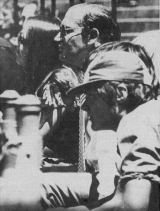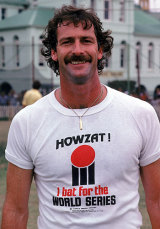The game was never the same
|
|

|
The play itself, between an Australian team led by Ian Chappell and a West Indian outfit captained by Clive Lloyd, did not actually look all that different. The ball was red. The players wore white and sported caps. The Australian headgear, though, was gold not green and it was such distinctions of detail that mattered. There were no traditions here. The ground, usually the preserve of Australian rules, had been converted by the installation of a pitch grown in a greenhouse. The television coverage, rather than relying on the usual two cameras, used eight, with extensive reliance on video replays. Microphones embedded in the ground near the stumps captured the players' grunts and the wickets' rattle; a boundary interviewer even solicited their post-dismissal musings. Critics were already calling this a pirate enterprise: its symbol, a stylised set of black stumps partially enclosing an outsized red cricket ball, would become the game's equivalent of the skull and crossbones.
Cricket had been cleft in twain almost six months. The first plans for WSC and the first international cricketers recruited by the agents of its impresario Kerry Packer, had been revealed in April 1977. The principles seemingly at stake - love of country versus love of money, a century of tradition versus spontaneous spectacle - had been endlessly debated. But until that December morn, the rivalry's implications had been obscure. Packer's original objective, indeed, had not been to introduce an alternative brand of cricket at all. His eyes were on the prize of exclusive Test match broadcasting rights in Australia; WSC was merely a roundabout way of bending the Australian Cricket Board to his will. Now it was a twin-match, twin-tour, twin-channel reality. "The public will decide," pronounced the editor of Wisden, Norman Preston.
The public issued what looked like a decision that very day. Where there were no traditions, there were also no spectators. While about 12,000 attended the Brisbane Test, fewer than 500 were scattered round the concrete tiers of VFL Park where space could be found for 80,000. Packer had more stars than Broadway: the Chappells, Dennis Lillee, Rod Marsh, Doug Walters, David Hookes versus Lloyd, Viv Richards, Joel Garner, Michael Holding, Andy Roberts, with Tony Greig, Barry Richards, Mike Procter, Imran Khan and Asif Iqbal to come. But for what, punters pondered, were they playing? It clearly was not for their country. It looked, uncomfortably, as though they might be playing for money.
The story of WSC is strewn with useful lessons and this one counted and has continued to count: that patrons seek some transcendant value in sport. Money alone won't do. They understand that the labourer is worthy of his hire. They may even obtain a frisson from the sheer vastness of a modern athlete's earnings. But they do not support sport because they perceive it as a group of people earning a living. And they do not believe that an athlete being paid a multiple of his previous salary will be trying commensurately harder and playing proportionately better. In this they are actually more in tune with sportsmen and women than most administrators and managers. Nobody will undo sport's stealthy permeation by money but introducing money to a sporting ecosystem cannot help but strain the bond between spectator and spectacle: the wide open spaces on Australia's National Rugby League terraces, attesting patrons' disillusionment with players who took the Murdoch shilling during the Super League battles, are reminiscent of nothing more strongly than those seen during WSC's first season.
Where Packer went right and Murdoch wrong is not entirely about judgement. Packer had the huge advantage that sport 25 years ago was dirt cheap. As Lamar Hunt's father had warned him when they set up the World Championship Tennis breakaway in the early 1970s: "If you're not careful, Lamar, you'll go broke in a hundred years." The Murdoch irruption on rugby league in the mid-1990s came when the game was already fully priced - his recent complaints about the inflation in the value of sporting properties seem as perverse as George Soros' denunciation of currency speculators.
Packer was smart enough, though, to realise that the money was useful to him only insofar as it obtained talent. The selling of WSC required more old-fashioned devices. The following season saw the launch of the most successful marketing campaign in cricket's history - the defining one, in fact. The strains of the "C'Mon Aussie C'Mon" chant devised by the admen at Mojo can still set a purists' teeth on edge but none could dispute its efficacy in arousing the patriotic nerve of Australian fans. Then, crucially, the WSC Australians began winning, including a night-time limited-overs match at the SCG on November 28, 1978 that drew more than 50,000.
|
|

|
In the meantime an underpowered Australian Test team was being steadily overwhelmed by Mike Brearley's England, with a disastrous impact on the official exchequer. The establishment's defiant rhetoric had tended to obscure how poorly equipped it was to deal with a rival cricket promoter. It had only one source of sizeable revenue (Test cricket), from which to fund a set of cost centres (first-class, club and junior cricket); sponsorship and broadcasting monies were as yet paltry. That source of revenue, furthermore, had been predicated on a monopoly market position, which no longer pertained.
Packer, meanwhile, enjoyed the advantages of vertical integration. He was paying his cricketers big bucks - or, at least, bigger bucks than they had been accustomed to. But he obtained for his bucks the additional bang of lots of popular, cheap, long-duration television for his summer schedules. And unlike the ACB, with its obligation to be all things to all fans, Packer had no need to stage matches outside the big markets of the eastern seaboard if he did not feel like it; in its second season, WSC did not visit Adelaide or Perth.
It could not go on. As Graham Yallop's callow XI succumbed in the sixth Test at the SCG, a lone voice was heard calling from the Hill: "Change the channel!" Which is what the ACB proceeded to do. From February through March 1979, WSC and the ACB worked toward a rapprochement under which Channel 9 obtained the broadcasting rights it had sought from the beginning. And they all lived happily ever after. Or so the story goes.
WSC's historical impact has been in dispute for most of the last quarter-century. Some have maligned it as the end for cricket as we knew it. Others have celebrated it as the beginning of cricket as we know it. For certain, cricket has never evolved so far so fast. Changes were wrought to the game's institutional structures in two years that might have taken 10 or more. The one-day international was popularised and the tri-cornered tournament made a feature of every subsequent Australian summer - a fashion that spread first through Asia, then to England.
Night cricket, coloured clothing and drop-in pitches were pioneered. Ditto helmets, which spread like mushrooms after rain when David Hookes had his jaw broken by Andy Roberts in December 1977. Administrators came to recognise television rights as an important revenue source. Cricketers became more cognisant of their market value. Broadcasters awoke to sport as popular mass entertainment, cheaper at that stage than just about everything except the evening weather. Television, too, ceased merely to be the game's silent witness. One of the features of Channel 9's coverage was the narrative it imposed on the play, drawing attention to this and that, laying out the issues of the day even as it monitored the events. Watch how necks crane to study the big screen replay when something happens at a big cricket arena today - making up for the wavering attention on the play itself - and you realise how the style of coverage conceived by Packer's lieutenant David Hill has both enriched and impoverished our understanding of the game.
Over the last couple of years, in fact, it has become harder to raise more than two cheers for WSC. The fact is that the animal spirits of the market, once liberated, were irrepressible; cricket's steady commodification began. As Dr Greg Manning has written, Packer paid $12 million "not to buy the cricket but to turn the cricket into something he could buy. The real meaning of his victory was that the game would never again be beyond price."
Because professionalism was launched so rapidly, it has ramified in ways quite unforeseen 25 years ago. What happens, for example, if the highest bidder for your services should turn out to be the agent of an abhorrent regime? By promulgating the idea that a professional cricketer "needs to make his living as much as any man" - as Justice Slade put it in his landmark High Court judgement in favour of the Packer organisation in October 1977 - WSC set the scene for a decade of steadily shabbier rebel tours to South Africa. What happens, too, if the highest bidder for your services should turn out to be a bookmaker? Then the only obstacle to your complicity is conscience - not a quality that has abounded in recent times. We live today, to use the famous Chinese curse, in interesting times. WSC helped make them so.
Gideon Haigh is a cricket historian and writer
